

Main. How to conduct a Web site competitive analysis. Hints and tips for doing it right (tom@tripledogdaremedia.com)Co-founder, Triple Dog Dare Media 01 Oct 2002 Conducting a competitive analysis is an important part of the job if you're a usability engineer or information architect.
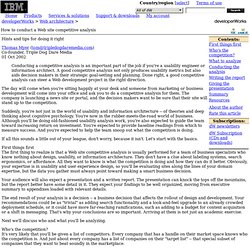
A good competitive analysis not only produces usability metrics but also aids decision makers in their strategic goal-setting and planning. Done right, a good competitive analysis can steer a Web development project in the right direction. The day will come when you're sitting happily at your desk and someone from marketing or business development will come into your office and ask you to do a competitive analysis for them. Suddenly, you're not just in the world of usability and information architecture -- of theories and deep thinking about cognitive psychology. If all this sounds a little out of your league, don't worry, because it isn't.
Your audience will also expect a presentation and a written report. Next we'll discuss who and what you'll be analyzing. Analysis Intelligence - Open Source Intelligence Analysis & Government Analysis, Clever Analysis Techniques. Africa. Royal United Services Institute for Defence and Security Studies Follow us on Africa RSS feed Research projects Africa This programme examines a region that is fast becoming a global feature in the defence and security landscape.
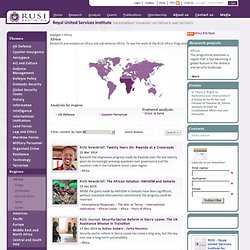
More Events Is There a Right to Humanitarian Intervention? Contacts Adrian Johnson. Improving Intelligence Analysis: Bridging the Gap between Scholarship and Practice. Evaluating Internet information. The Art of Complex Problem Solving. Critical Thinking On The Web. Top Ten Argument Mapping Tutorials.

Six online tutorials in argument mapping, a core requirement for advanced critical thinking.The Skeptic's Dictionary - over 400 definitions and essays. The Fallacy Files by Gary Curtis. Best website on fallacies. Butterflies and Wheels. What is critical thinking? Nobody said it better than Francis Bacon, back in 1605: For myself, I found that I was fitted for nothing so well as for the study of Truth; as having a mind nimble and versatile enough to catch the resemblances of things … and at the same time steady enough to fix and distinguish their subtler differences; as being gifted by nature with desire to seek, patience to doubt, fondness to meditate, slowness to assert, readiness to consider, carefulness to dispose and set in order; and as being a man that neither affects what is new nor admires what is old, and that hates every kind of imposture.
A shorter version is the art of being right. More definitions... Program for Critical Thinking 6 Dec 21 May. Crime and Intelligence Analysis Training Ltd. What They Don’t Teach in Detective School. I used to do a series of lectures about the skills I found most lacking in the education of detectives.

The lecture about evaluating the revealed wisdom that pours forth from the Internet was always fun to deliver. One example that I used when I started doing these, was a site that identified the second gunman in the Kennedy assassination — there was Elvis holding a Thompson sub-machine gun on the grassy knoll. It was on the Internet so it must be true. Here is the 13 point check list for evaluating information upon which I based the lecture. 1. 2. 3. 4. 5. 6. 7. Military Intelligence Professional Bulletin. OSS.Net, Inc. Home Page. Intelligence Failures. The wrong model for the war on terror The controversy surrounding the American pre-war intelligence assessment of Iraq’s weapons of mass destruction programs dominates the airwaves and print media.

Behind-the-scenes investigations spawned by the Iraq performance as well as the tragedies of September 11, 2001 offer a fleeting window of opportunity to chart and implement much-needed reforms of a beleaguered intelligence community. The intelligence community’s failure to warn with the clarity needed to disrupt the conspiracy of September 11 and its less-than-stellar performance in assessing Iraqi wmd programs highlight both the dangers to security and the demands for strategic intelligence in the twenty-first century.
The community can hardly be trusted to do an honest and balanced critique of its performance in the wake of these events. It comprises numerous intelligence agencies, each with its own set of entrenched interests. Open Source Intelligence OSINT. We need to rethink the distinction between open sources and secrets.
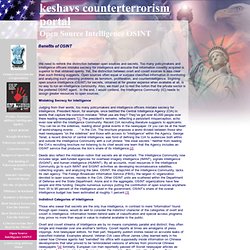
Too many policymakers and intelligence officers mistake secrecy for intelligence and assume that information covertly acquired is superior to that obtained openly. Yet, the distinction between overt and covert sources is less clear than such thinking suggests. Tools for creating ideas. Criminal Justice MegaLinks.
A New Intelligence Analysis Training Program. It’s nice, after several years of what seems to be an endless string of posts describing the numerous and easily avoidable pitfalls plaguing our state and local intelligence efforts, to be able to pass along some happier tidings.

Recently, I was invited to participate in a pilot program created by the Sacramento Regional Office of Homeland Security. The program is titled Intermediate Intelligence Analysis Training and is primarily geared for those working in one of the many fusion centers dotting the nations. Now, post 9/11, everyone and their brother has been trying (and generally succeeding) in getting their turn at the federal trough by promising new and exciting ways to bring intelligence analysis to state and local agencies with their unique brands of snake oil.
Sometimes it takes the form of someone with military or IC experience who comes in and tells war stories for a few hours. It’s geared towards ‘intermediate’ analysts. Indexer. Xanalys specialise in providing powerful software capabilities in threat assessment, Investigative major case management and advance crime and fraud analytics.
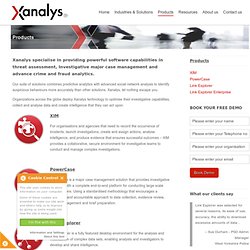
Our suite of solutions combines predictive analytics with advanced social network analysis to identify suspicious behaviours more accurately than other solutions. Xanalys, let nothing escape you. Organizations across the globe deploy Xanalys technology to optimise their investigative capabilities, collect and analyse data and create intelligence that they can act upon. For organisations and agencies that need to record the occurrence of incidents, launch investigations, create and assign actions, analyse intelligence, and produce evidence that ensures successful outcomes – XIM provides a collaborative, secure environment for investigative teams to conduct and manage complex investigations. PowerCase Link Explorer Link Explorer Enterprise. Intermediate Fusion Center Analyst Training Program (IFCAT) This 125-hour intermediate analyst training program was developed following a nationwide fusion center analyst job task analysis and meetings with subject-matter experts from throughout the country.
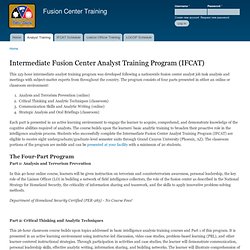
The program consists of four parts presented in either an online or classroom environment: Analysis and Terrorism Prevention (online) Critical Thinking and Analytic Techniques (classroom) Communication Skills and Analytic Writing (online) Strategic Analysis and Oral Briefings (classroom) Critical Thinking and Intelligence Analysis. Intelligenceanalysistraining.com. Links [Pajek Wiki] 5 Whys. The 5 Whys is an iterative question-asking technique used to explore the cause-and-effect relationships underlying a particular problem.[1] The primary goal of the technique is to determine the root cause of a defect or problem.
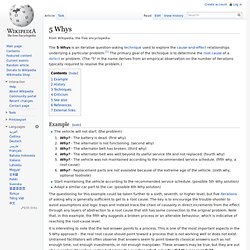
(The "5" in the name derives from an empirical observation on the number of iterations typically required to resolve the problem.) Example[edit] The vehicle will not start. Crime Academy. Intelligence Analysis Training Review – Part 4. Part 1 Part 2 Part 3 In my last post I focused primarily on how the course was presented. There were a number of other observations about the class that seem worthy of note. Intelligence Analysis index. Analysis - CATN - ToC. Air War College Gateway to the Internet. Intelligence analysis - Mashpedia, the real-time encyclopedia. Intelligence analysis is the process of taking known information about situations and entities of strategic, operational, or tactical importance, characterizing the known, and, with appropriate statements of probability, the future actions in those situations and by those entities. The descriptions are drawn from what may only be available in the form of deliberately deceptive information; the analyst must correlate the similarities among deceptions and extract a common truth.
Although its practice is found in its purest form inside intelligence agencies, such as the Central Intelligence Agency (CIA) in the United States or the Secret Intelligence Service (SIS, MI6) in the UK, its methods are also applicable in fields such as business intelligence or competitive intelligence. Overview[edit] Obviously, a set of problem-solving talents are essential for analysts. Analytic tradecraft[edit] "Analytic tradecraft skills also serve as "force multipliers", helping us provide top-quality analysis: Certificate Programs: Crime and Intelligence Analysis Certificate. Professional Certificate in Crime and Intelligence Analysis Learn how to effectively analyze criminal activity in UCR Extension's Certificate in Crime and Intelligence Analysis.
This program is offered in cooperation with the state of California Department of Justice. Courses focus on the analysis of crimes that most frequently come to the attention of field and investigative officers and are of interest to intelligence officers. Participants in the certificate program will learn how to: Analyze crime and use law enforcement data to forecast when and where criminals are likely to strike.Detect and understand distinctions among crime patterns.Use crime and intelligence information to create directed patrol or tactical action plans that lead to an effective response.Collect data, subject it to statistical tests, develop and test hypotheses, and write conclusions that adhere to commonly accepted criminal justice research standards.
Who Can Benefit? Read a student success story. Course Schedule.